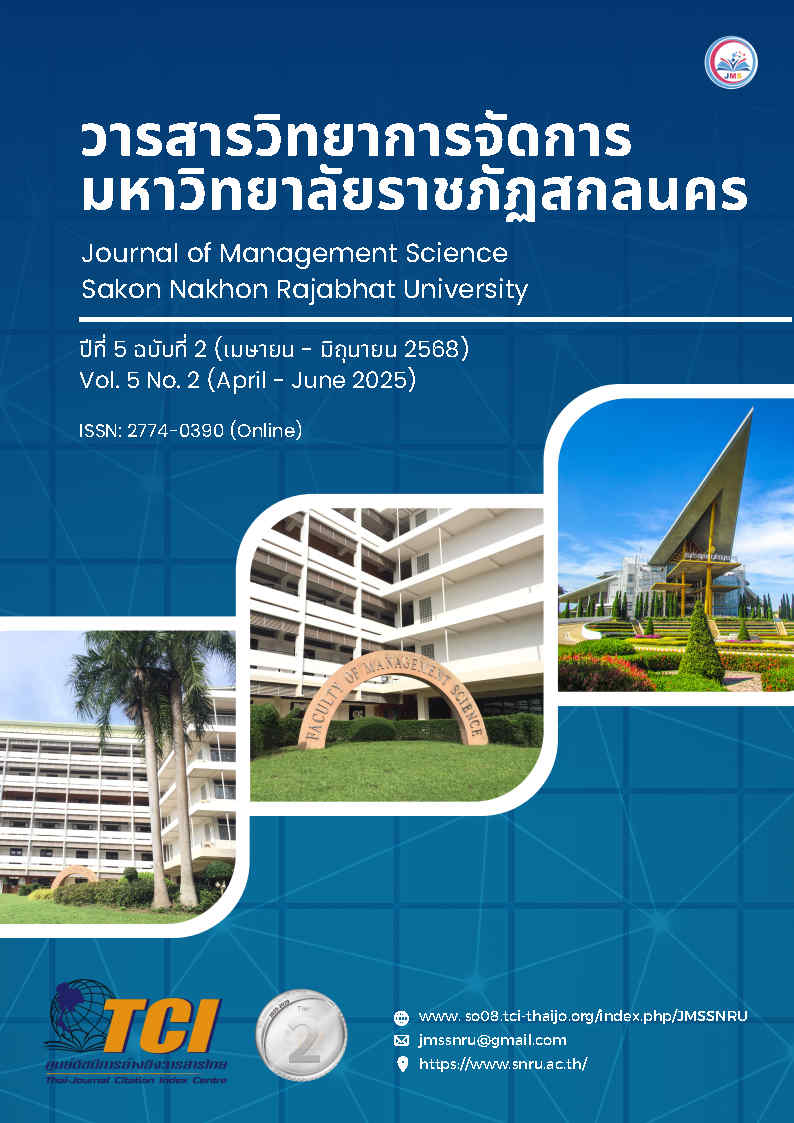The management model for educational quality assurance at the Program Level According to AUN-QA Criteria, Faculty of Education, Sakon Nakhon Rajabhat University
Keywords:
education management, quality assurance in education, manual, AUN-QA criteriaAbstract
The objectives of this research were to 1) develop a management model for educational quality assurance according to AUN-QA criteria for the Faculty of Education, Sakon Nakhon Rajabhat University, 2) develop a handbook for managing educational quality assurance based on AUN-QA criteria for the Faculty of Education, Sakon Nakhon Rajabhat University and 3) test the handbook for managing educational quality assurance according to AUN-QA criteria for the Faculty of Education, Sakon Nakhon Rajabhat University. The population consisted of 98 personnel from the Faculty of Education, Sakon Nakhon Rajabhat University. The sample group consisted of 53 individuals including administrators, program instructors and quality assurance staff from the Faculty of Education. The research tools included the educational quality assurance management model and handbook based on AUN-QA standards for the Faculty of Education at Sakon Nakhon Rajabhat University, interview forms for the target group, surveys to gather expert opinions on the model and handbook, and surveys to collect participants' feedback on the handbook activities. The statistics used for data analysis were basic statistics including mean and standard deviation. The research results revealed that 1) the educational quality assurance management model according to AUN-QA criteria for the Faculty of Education, Sakon Nakhon Rajabhat University consisted of 4 parts: Part 1-Planning (Plan) which included policy setting and responsibility assignment, Part 2-Implementation (Do) which included designating responsible individuals, determining reference evidence and organizing SAR writing training, Part 3-Checking (Check) which included assigning responsible individuals to review the SAR before submitting it to the evaluation committee and Part 4-Improvement (Act) which included organizing training for curriculum development planning and specifying relevant personnel required to attend the training. The experts' opinions on the overall model were at the highest level of appropriateness, 2) The development of the handbook consisted of four parts: Part 1-Details of the model, Part 2-Explanation of criteria and methods for writing SAR Criterion 1–Criterion 8 with examples, Part 3-Guidelines for program assessment, examples of Desktop Assessment reports and Feedback Reports and Part 4-Examples of curriculum development planning. The experts' opinions on the overall handbook were at the highest level of appropriateness and 3) The results of testing the handbook with the sample group showed that their overall satisfaction was at its highest level.
References
กัญคดา อนุวงศ์, อาจรี ศุภสุธีกุล, วัยวุฑฒ์ อยู่ในศิล, นิธินาถ ศุภกาญจน์, ปิ่นปินัทธ์ ดำนุ้ย และประพฤทธิ์ สวัสดิ์วิภาชัย. (2565). ความเข้าใจของผู้ประเมินคุณภาพภายในต่อสาระของเกณฑ์ประกันคุณภาพการศึกษาเครือข่ายมหาวิทยาลัยอาเซียน (AUN-QA) ระดับหลักสูตร. วารสารมหาวิทยาลัยศรีนครินทรวิโรฒ (สาขาวิทยาศาสตร์และเทคโนโลยี), 14(28), 28–35.
คณะวิทยาศาสตร์ มหาวิทยาลัยมหิดล. (2567). กรอบมาตรฐานคุณวุฒิอุดมศึกษา. สืบค้น 1 มีนาคม 2568 จาก https://quality.sc.mahidol.ac.th/tqf/.
งานประกันคุณภาพการศึกษา. (2568). คู่มือการปฏิบัติงาน แนวทางการประกันคุณภาพการศึกษา AUN-QA Version 4.0 คณะบริหารธุรกิจ สถาบันเทคโนโลยีพระจอมเกล้าเจ้าคุณทหารลาดกระบัง. สืบค้น 1 มีนาคม 2568 จาก https://www.kbs.kmitl.ac.th/wp-content.
ณัฏฐ์ณพัชร์ อ่อนตาม. (2562). เทคนิคการบริหารงานแบบ PDCA. วารสารสมาคมพัฒนาวิชาชีพการบริหารการศึกษาแห่งประเทศไทย, 1(3), 39–46.
ณัฐปาลิน นิลเป็ง. (2560). ผู้นําการเปลี่ยนแปลงในศตวรรษที่ 21. วารสารการพยาบาลและการดูแลสุขภาพ, 35(1), 16-29.
ธนวัฒน์ กองแก้ว และนิคม นาคอ้าย. (2565). ภาวะผู้นําการเปลี่ยนแปลงของผู้บริหารสถานศึกษาสังกัดสํานักงานเขตพื้นที่การศึกษามัธยมศึกษาพิษณุโลกอุตรดิตถ์. Journal of Roi Kaensarn Academi, 7(8), 322–333.
ธีรศักดิ์ สารสมัคร, ไพรวัลย์ โคตรรตะ และชวนคิด มะเสนะ. (2563). ภาวะผู้นําการเปลี่ยนแปลงของผู้บริหารสถานศึกษาในยุคการศึกษา 4.0 สังกัดสำนักงานเขตพื้นที่การศึกษามัธยมศึกษา เขต 29. ในการประชุมวิชาการและนําเสนอผลงานวิจัยระดับชาติ ราชธานีวิชาการ ครั้งที่ 5 “การวิจัยเพื่อการเปลี่ยนแปลง (Research to Make A CHANGE)” (หน้า 348–358). อุบลราชธานี: มหาวิทยาลัยราชธานี.
ธีรพงศ์ ทับอินทร์. (2558). การใช้วงจรเดมมิ่ง (PDCA) ในการบริหารงานวิชาการของโรงเรียนมัธยมศึกษา สังกัดสำนักงานเขตพื้นที่การศึกษามัธยมศึกษา เขต 42. วารสารชุมชนวิจัยและพัฒนาสังคม มหาวิทยาลัยราชภัฏนครราชสีมา, 9(2), 68-78.
ธีระพงษ์ เลิศทิฐิวงศ์, วรปภา อารีราษฎร์ และธรัช อารีราษฎร์. (2567). ผลการทดลองใช้คู่มือกลไกการบริหารจัดการเทคโนโลยีดิจิทัลแพลตฟอร์มตลาดกลางพาณิชย์อิเล็กทรอนิกส์แบบมีส่วนร่วมเพื่อส่งเสริมการจัดจำหน่ายสินค้าสำหรับวิสาหกิจชุมชน. วารสารมหาวิทยาลัยราชภัฏมหาสารคาม. 18(3), 220-235.
นิเวศน์ วงศ์สุวรรณ และอินถา ศิริวรรณ. (2560). การบริหารแบบมีส่วนร่วม. วารสารมหาจุฬาวิชาการ มหาวิทยาลัยมหาจุฬาลงกรณราชวิทยาลัย, 4(1), 176–187.
บรรณกร แซ่ลิ่ม. (2567). แนวทางการพัฒนาคุณภาพระดับหลักสูตรตามเกณฑ์ AUN-QA. คณะศิลปศาสตร์ มหาวิทยาลัยสงขลานครินทร์. วารสารมนุษยศาสตร์และสังคมศาสตร์ มหาวิทยาลัยมหาสารคาม. 43(1). 84-96.
บุญชม ศรีสะอาด. (2560). การวิจัยเบื้องต้น (พิมพ์ครั้งที่ 10). กรุงเทพฯ: สุวีริยาสาส์น.
ประกาศคณะกรรมการมาตรฐานการอุดมศึกษา. (2565, 9 กันยายน). ประกาศคณะกรรมการมาตรฐานการอุดมศึกษา เรื่อง รายละเอียดผลลัพธ์การเรียนรู้ตามมาตรฐานคุณวุฒิระดับอุดมศึกษา พ.ศ. 2565. ราชกิจจานุเบกษา. 139(ตอนพิเศษ 212 ง), 35–36.
พงศธร สรภูมิ และสุทธิพงศ์ บุญผดุง. (2565). การประยุกต์ใช้วงจรการบริหารงานคุณภาพ PDCA: กรณีศึกษาโรงเรียนวัดใหม่เนิน. รายงานการประชุม Graduate School Conference, 4(1), 1409-1416.
มนต์ชัย เทียนทอง. (2545). การออกแบบและพัฒนาคอร์สแวร์สำหรับบทเรียนคอมพิวเตอร์ช่วยสอน. ภาควิชาคอมพิวเตอร์ศึกษา คณะครุศาสตร์อุตสาหกรรม สถาบันเทคโนโลยีพระจอมเกล้าพระนครเหนือ.
วรปภา อารีราษฎร์. (2556). การพัฒนาซอฟต์แวร์ทางการศึกษา. มหาสารคาม: อภิชาติการพิมพ์.
อวยพร เรืองศรี. (2567). การวิเคราะห์ผลการประเมินคุณภาพภายใน ตามเกณฑ์ AUN-QA ระดับหลักสูตร ปีการศึกษา 2564 มหาวิทยาลัยวลัยลักษณ์. Science, Technology, and Social Sciences Procedia, 2024(2), NCR2R23.
ASEAN University Network Quality Assurance. (2020). The guide to AUN-QA assessment at programme level version 4.0. ASEAN University Network.
Best, J. W., & Khan, J. V. (1998). Research in education (8th ed.). Boston: Allyn & Bacon.
Downloads
Published
How to Cite
Issue
Section
License
Copyright (c) 2025 JOURNAL OF MANAGEMENT SCIENCE SAKON NAKHON RAJABHAT UNIVERSITY

This work is licensed under a Creative Commons Attribution-NonCommercial 4.0 International License.
An article published in the Journal of Management Science. Sakon Nakhon Rajabhat University is the opinion, copyright and responsibility of the author of the work.







